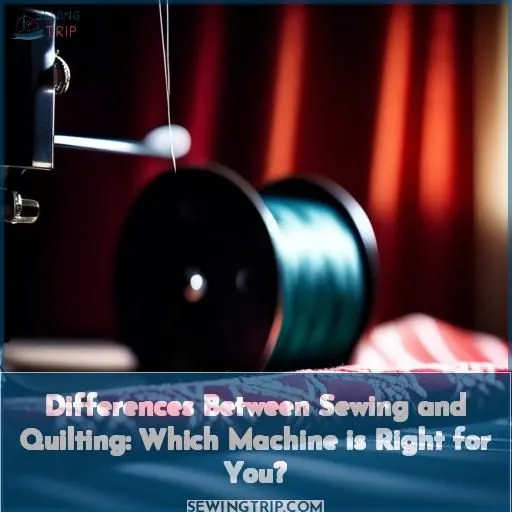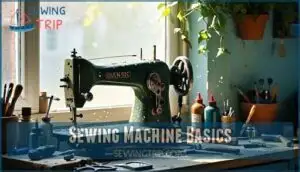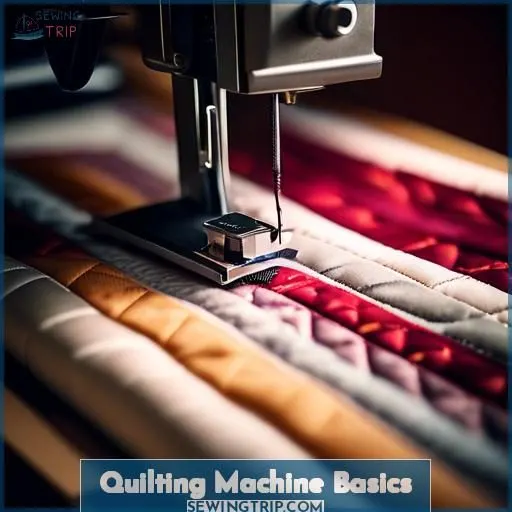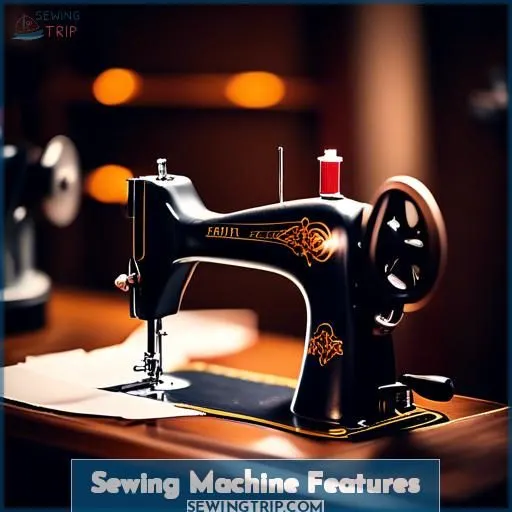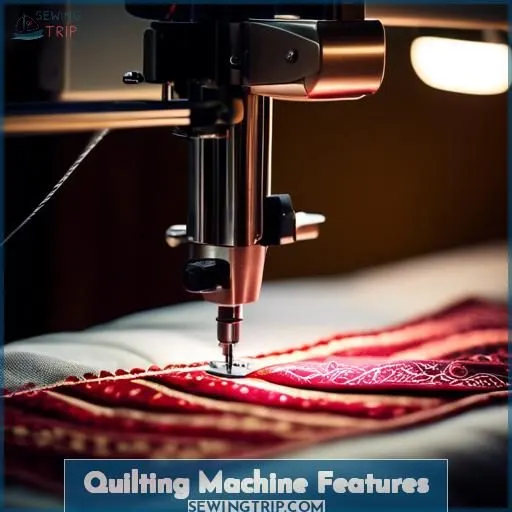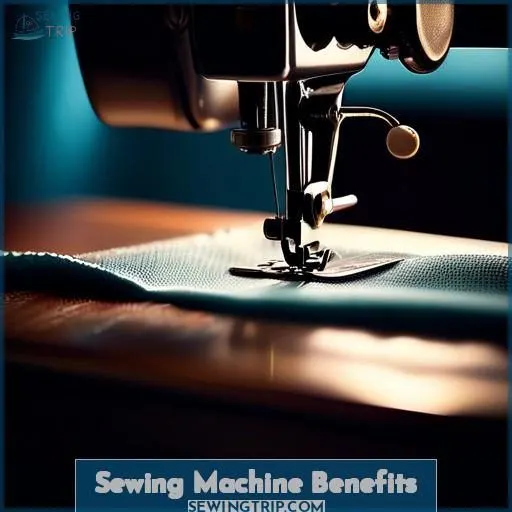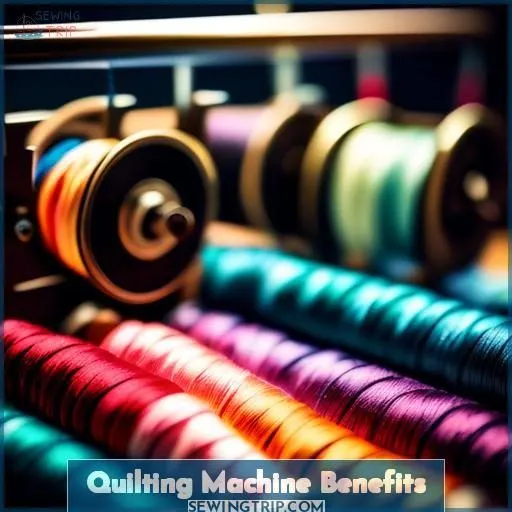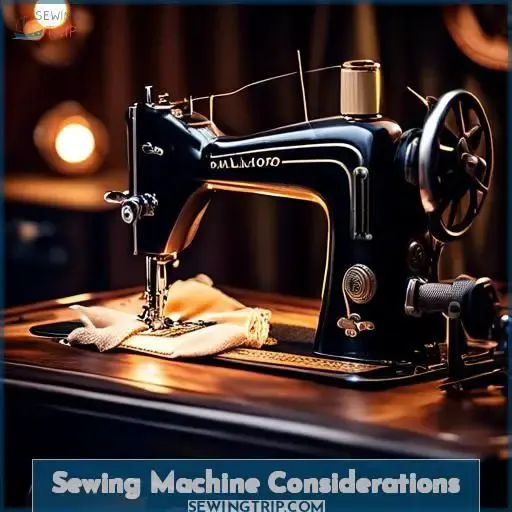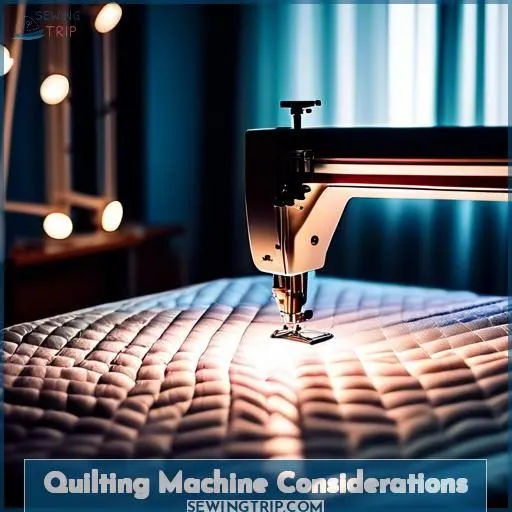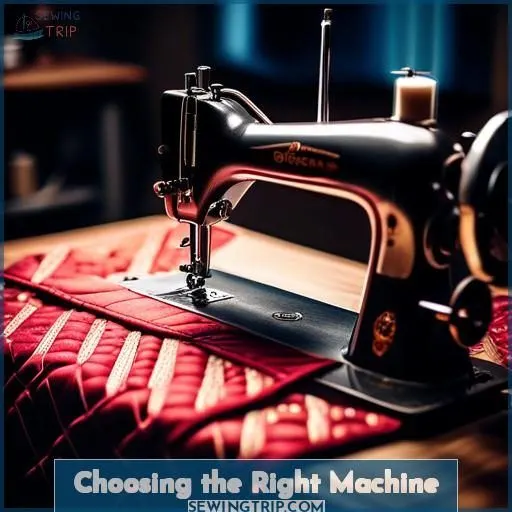This site is supported by our readers. We may earn a commission, at no cost to you, if you purchase through links.
You’re pursuing two distinct fabric crafts—sewing and quilting—each requiring specialized machines designed for their unique techniques and processes.
Sewing machines offer flexibility for handling various tasks.
Quilting machines excel at complex stitches and high speeds crucial for quilting.
Differences between sewing and quilting lie in workspace size, decorative stitch capabilities, fabric handling, and overall machine performance.
Quilting machines boast larger workspaces, a broader range of decorative stitches, and enhanced speed and stability.
However, sewing machines offer greater affordability and portability.
To fully comprehend which machine aligns with your needs, explore the subtleties that distinguish these remarkable fabric arts.
Table Of Contents
Key Takeaways
- Sewing machines are versatile tools that can handle a variety of sewing tasks, while quilting machines are tailored to the art of quilting, providing a diverse array of needle styles and thread tension adjustments to fulfill the distinct requirements of quilting techniques.
- Quilting machines offer speed and stability, rendering them ideal for larger projects, while sewing machines are more cost-effective and portable.
- Quilting processes involve selecting the appropriate thread types, fabric choices, and quilting patterns, while sewing processes are the steps involved in creating a seam, which is the connection between two pieces of fabric.
- Quilting machines have a larger workspace and extension table, enabling bulky fabrics to pass through effortlessly, while sewing machines usually have a more diminutive workspace, which can be restrictive for quilters who need to handle more prominent fabric pieces.
Sewing Machine Basics
Sewing machines are versatile tools that can handle a variety of sewing tasks. They come with different bobbin types, needle gauges, and thread weights to accommodate different fabrics and projects. Presser feet and stitch length adjustments help achieve the desired results.
Sewing machines are used for seams, buttons, borders, and decorations, making them essential for both beginners and experienced sewers. However, for specialized quilting tasks, a quilting machine is the better choice.
Quilting Machine Basics
Quilting requires specialized techniques and equipment beyond basic sewing. Do you know the key differences between sewing and quilting processes, and how they impact the type of machine you’ll need?
Types of Stitches
Now that we’ve covered the fundamentals of sewing machines, let’s venture into the realm of quilting machines. These purpose-built machines are tailored to the art of quilting, providing a diverse array of needle styles, thread tension adjustments, and fabric compatibility to fulfill the distinct requirements of quilting techniques.
With quilting machines, you can explore varying stitch sizes and pressure feet to craft elaborate patterns and designs. Whether you’re an experienced quilter or embarking on this pursuit, comprehending the range of stitches offered by a quilting machine is crucial for excelling in the art of quilting.
Sewing Processes
Sewing processes are the steps involved in creating a seam, which is the connection between two pieces of fabric. These processes include selecting the appropriate seam allowance, using decorative stitches, and feeding multiple fabric layers through the machine.
- Seam Allowance: The distance from the raw edge of the fabric to the seamline is the seam allowance. It provides excess fabric for efficiently stitching a seam together and prevents the fabric from fraying.
- Decorative Stitches: These are stitches that add a unique touch to a project, such as embroidery stitches or alphabets.
- Fabric Layers: Sewing processes involve working with multiple layers of fabric, which can be challenging for both the sewer and the machine.
Machine features, such as needle types and stitching speed, can also impact the sewing process. For example, a walking foot can help feed multiple layers of fabric through the machine, while a darning or free-motion foot can be used for quilting.
Sewing machines offer a variety of stitch types, including straight stitches and decorative stitches, which can be selected based on the intended use of the project. The speed and efficiency of sewing machines can also impact the sewing process, with some models offering high speeds for increased productivity.
Quilting Processes
Quilting is an art form that demands patience and precision. The process entails selecting the appropriate thread types, fabric choices, and quilting patterns. Binding techniques and appliqué designs contribute a personal flair to your creation.
Padded material is prevalent in quilting, and straight line quilting and free motion quilting are two primary techniques. Comprehending the distinctions between sewing and quilting is essential for selecting the suitable machine.
Quilting machines provide speed and stability, rendering them ideal for larger projects.
Sewing Machine Features
In the realm of sewing and quilting, the workspace, accessories, and features play a pivotal role, alongside the stitching speed and efficiency of your machine. From the expanse of the harp space to the myriad of embellishing stitches, grasping the implications of these factors on your projects will empower you to select the most suitable machine for your endeavors.
Workspace
Workspace is a vital consideration when selecting the ideal sewing or quilting machine. Here’s what to keep in mind:
- Needle threader: Look for a machine with a user-friendly needle threader to minimize time consumption and irritation.
- Bobbin winding: A machine featuring an automated bobbin winding mechanism can save you time and exertion.
- Fabric tension: Adjustable fabric tension guarantees consistent stitching, preventing puckering or bunching.
- Presser foot pressure: Adjustable presser foot pressure allows for enhanced control during the stitching process.
- Twin needle: A twin needle can be advantageous for sewing multiple layers or creating decorative stitching.
- Quarter inch foot add-on option: A quarter inch foot add-on option can facilitate precise seam allowances.
- Darning or free-motion foot add-on option: These feet can be beneficial for specialized quilting techniques.
- Walking foot add-on option: A walking foot can aid in feeding multiple layers and minimizing puckering.
Accessories and Features
Concerning sewing machines, the attachments and features can substantially impact your sewing experience. Let’s explore the realm of sewing machine features, commencing with presser feet. These attachments secure the fabric against the feed dogs, guiding it through the machine during stitching. Some widely used presser feet include the zipper foot, buttonhole foot, and multi-purpose foot.
Another indispensable feature is the throat space, denoting the distance between the needle and the rear of the presser foot. A larger throat space affords greater flexibility when sewing, particularly when dealing with larger projects or navigating around bulky fabrics.
Needles are another essential accessory for any sewing machine. Superior-quality needles, such as those from Schmetz, can minimize skipping and facilitate a smoother sewing experience.
Regarding the machine itself, contemplate the features that hold the most significance for you. An expanded workspace can furnish more room to manipulate your project, while automatic end-of-stitch features can conserve time and effort. Furthermore, some machines incorporate built-in computers that automate stitching, rendering them more versatile.
When selecting a sewing machine, contemplate your intended use, the features that are paramount to you, and the available space and budget. Bear in mind that the ideal machine for you’ll be contingent upon your unique requirements and preferences.
Stitching Speed and Efficiency
When you’re in the thick of a sewing project, speed and efficiency aren’t just nice-to-haves; they’re your best pals. Imagine your machine humming along, where automation meets ergonomics, effortlessly handling fabric of any thickness. With each stitch quality unmatched and thread tension just right, you’re not just sewing; you’re crafting a masterpiece with every press of the pedal.
Quilting Machine Features
As regards quilting, the workspace and extension table are critical factors to take into account. Ornamental stitches, quickness, and steadiness also distinguish quilting machines, providing quilters with enhanced adaptability and productivity.
Workspace and Extension Table
Essential to quilting is workspace. Quilting machines possess a larger harp space, enabling bulky fabrics to pass through effortlessly.
Furthermore, many quilting machines can incorporate an extension table, offering ample space for extensive projects such as queen-size quilts.
With these attributes, quilting machines are well-equipped to manage the thickness and weight of quilt fabrics, guaranteeing a smooth and efficient quilting experience.
Decorative Stitches
Quilting machines offer a wide range of decorative stitches that can add unique patterns and styles to your quilts. These stitches can be used for appliquing techniques, where pieces of fabric are sewn on top of the quilt to create designs.
The most common decorative stitches include zigzag stitch, embroidery stitch, and blanket stitch, which can be used to secure raw edges and outline applique shapes. Quilting machines often have a variety of stitch widths and lengths, allowing you to customize the look of your quilt.
By experimenting with different stitches and techniques, you can create visually appealing and professional-grade quilts that showcase your creativity and skill.
Speed and Stability
Regarding speed and stability, quilting machines excel over sewing machines. Quilting machines operate at high velocities, allowing you to finish projects more expeditiously. They also provide steadfastness, which is paramount for quilting multiple layers.
However, quilting machines are more costly than sewing machines and may necessitate more space. It is imperative to take these factors into account when selecting the appropriate machine for your requirements.
Sewing Machine Benefits
Sewing machines can simplify the quilting process by enhancing quilting accuracy and increasing project completion speed. With features like needle up/down functions and 1/4 seam allowances, sewing machines make it easier to feed multiple fabric layers and create visually appealing, professional-grade quilts.
Enhanced Quilting Accuracy
Sewing machines provide improved quilting accuracy with features like needle control and thread tension adjustments. These adjustments guarantee that your quilt size and fabric thickness are uniform, resulting in a professional-quality finish. Moreover, altering stitch length enables greater precision in your quilting process. By utilizing these features, you can master the art of quilting with ease.
Simplified Fabric Feeding
After perfecting quilting accuracy, let’s explore the effortless fabric feeding. Your sewing machine’s feed dog teeth are the unsung heroes here, ensuring a steady fabric grip regardless of thickness. It’s akin to having an extra pair of hands that never tire. Adjusting tension is a seamless process, eliminating any concerns about material compatibility. Here’s a quick comparison:
| Feature | Sewing Machine | Quilting Machine |
|---|---|---|
| Feed Dog Teeth | ||
| Fabric Thickness Adaptability | ||
| Fabric Grip | Strong | Stronger |
| Material Compatibility | High | Higher |
| Tension Adjustment | Easy | Easier |
Increased Project Speed
Boost your sewing game with increased project speed! Sewing machines offer versatility, allowing you to tackle various tasks with ease.
Storage is a breeze with these machines, as they often come with built-in drawers or cabinets.
Regular maintenance keeps them running smoothly, ensuring your projects are always on time.
Inspiration strikes when you can sew faster, giving you more time to create and explore new techniques.
Quilting Machine Benefits
Are you searching for a machine that can simplify your quilting projects and add a touch of style? Quilting machines excel at enhancing accuracy, feeding multiple fabric layers with ease, and producing visually striking results in less time.
Accuracy and Simplicity
Quilting machines offer a level of accuracy and simplicity that sewing machines can’t match. With features like needle up/down functions and 1/4 seam allowances, quilting machines make it easier to create precise stitches and maintain consistent tension.
Additionally, the larger work area and extension table on quilting machines allow for more efficient and comfortable sewing. This makes quilting machines an excellent choice for those who value accuracy and simplicity in their sewing projects.
Feeding Multiple Layers
Quilting machines are designed to feed multiple layers of fabric with ease. They offer features like needle penetration, thread tension control, and adjustable seam allowance to accommodate thicker fabrics.
The stitch density can be adjusted to guarantee that the layers are held together securely. This capability is essential for quilting, as it allows for the creation of intricate patterns and designs across multiple layers of fabric.
Style and Completion Speed
The style and completion speed of quilting machines are key factors for quilters. Quilting machines enhance the style of quilts with their diverse range of decorative stitches, which can add distinctive patterns and designs to the quilt.
Moreover, quilting machines offer fast speeds and stability, allowing quilters to complete projects more productively. This is especially advantageous when working with multiple layers, as quilting machines streamline the process and accelerate project completion speed.
Sewing Machine Considerations
In the realm of selecting a sewing machine, the work area and accessible attachments can have a profound effect on your quilting endeavors. Furthermore, the stitch count per minute is a pivotal consideration, as it can have a substantial impact on the duration of your project’s execution.
Discussion Point(s)
When choosing between sewing and quilting machines, it’s like picking a dance partner for the fabric fiesta. Here’s a quick spin around the floor:
- Differences in Purpose: Sewing machines jive with general tasks, while quilting machines waltz through layers.
- Machine Durability: Quilting machines are the marathon runners, built to last longer stretches.
- Beginner Friendliness: Sewing machines are the welcoming committee, easier for novices.
- Brand Reliability & Stitch Variety: Not all brands can do the twist. Look for one that offers a rich library of stitches and stands the test of time.
Workspace
In terms of sewing machines, the workspace is a crucial aspect to contemplate. The workspace’s dimensions can significantly impact your sewing experience, particularly when tackling extensive endeavors like quilting. Sewing machines usually have a more diminutive workspace, which can be restrictive for quilters who need to handle more prominent fabric pieces. Conversely, quilting machines are engineered with a larger workspace, often measuring approximately 9 inches in width and 6 inches in height. This more extensive workspace enables the effortless handling of larger quilts and provides greater flexibility for intricate designs.
In addition to the workspace’s size, quilting machines also proffer an extension table, which can be attached to provide even more room for your project. This feature is especially advantageous for those working on more extensive quilts or those who prefer a more spacious working environment.
When comparing the workspaces of sewing and quilting machines, it’s evident that quilting machines offer a more expansive area for working, making them the superior option for quilters. However, when selecting between a sewing machine and a quilting machine, it’s vital to consider additional factors such as the stitch types, sewing methods, and quilting techniques.
Accessories
Accessories are an essential component of any sewing or quilting project, and they can greatly affect the outcome of your work. Let’s examine some key accessories that are critical for both sewing and quilting machines.
Firstly, presser feet are an indispensable accessory for any sewing machine. They come in various shapes and sizes, each designed for specific tasks. For example, a zipper foot is ideal for sewing zippers, while a buttonhole foot is optimal for creating buttonholes. Quilting machines may also have specialized presser feet, such as a walking foot, which assists in feeding multiple layers of fabric evenly.
Next, needle types can also have an impact on the outcome of your project. Quilting machines often come with an array of needle types, such as ballpoint needles, which are excellent for sewing through multiple layers of fabric without damaging the top layer. For sewing machines, universal needles are a popular option, as they can be used for a wide variety of fabrics and projects.
Bobbin tension is another important factor to take into account. Proper bobbin tension is essential for creating strong, durable seams. Adjusting the bobbin tension can be done by tightening or loosening the screw on the bobbin case. This can be especially important when working with heavy-weight fabrics or when using a twin needle.
Thread tension is another critical accessory. It guarantees that the top thread and bobbin thread have the correct tension, resulting in aesthetically pleasing, flat, and even stitches. Most sewing machines have a tension regulator, which can be adjusted to tighten or loosen the tension discs that the thread passes through before it goes up and through the looper.
Finally, fabric types can also influence the choice of accessories. For example, when working with delicate fabrics like silk or lace, a ballpoint needle and a walking foot can help prevent damage. Similarly, when working with heavy-weight fabrics like denim, a heavy-duty needle and presser foot can be beneficial.
Stitching Counts per Minute
In regard to stitches per minute, multiple circumstances need examination, including stitch length, tension settings, presser foot pressure, needle size, and bobbin type. These circumstances can profoundly affect the performance and efficiency of your sewing or quilting machine. Here’s a list of three important points to bear in mind:
- Stitch Length: The length of your stitches can impact the overall appearance and strength of your seams. A longer stitch length may be appropriate for certain fabrics or projects, while a shorter stitch length may be preferred for others. Adjusting the stitch length can help you achieve the desired results.
- Tension Settings: Proper tension settings are essential for maintaining consistent stitching and preventing thread breakage. Different fabrics and thread types may need different tension settings, so it’s vital to experiment and find the right equilibrium for your project.
- Presser Foot Pressure: The pressure applied by the presser foot can influence the stitch quality and the ease of sewing. A higher presser foot pressure may be required for thicker fabrics or when using certain stitches, while a lower pressure may be more appropriate for delicate fabrics or when using a walking foot.
Quilting Machine Considerations
When contemplating a quilting machine, it’s imperative to balance the expenditures and spatial constraints against your proficiency and sought-after attributes. With a plethora of manufacturers and variants offered, choosing the optimal machine necessitates meticulous investigation and experimentation.
Cost and Space
Entering the realm of quilting machines, you’ll discover that the price comparison can be illuminating. Unlike their sewing equivalents, these formidable machines require more than just a nook in your abode. Spatial considerations extend beyond accommodating the machine; factor in storage requirements for fabrics and implements.
A robust table will become an indispensable anchor for your artistic pursuits, as you bid farewell to portability.
Mastery and Variation
Mastering a quilting machine requires time and dedication. The power of the machine, thread tension, needle selection, and fabric thickness all play a role in your success. Regular upkeep is essential to keep your machine running smoothly. With practice, you’ll become more confident in your quilting skills and enjoy the creative freedom that comes with using a quilting machine.
Selection and Quality
Regarding the selection of a quilting machine, cost, quality, durability, versatility, and dependability are essential aspects. You desire a machine that will serve you well for an extended period, providing precise stitching and the capability to handle diverse quilting techniques.
Firstly, let’s address cost. Quilting machines can range from a few thousand dollars to tens of thousands, depending on the brand, features, and intended purpose. Longarm quilting machines, designed for heavy-duty quilting, tend to be more costly than traditional sewing machines. Nevertheless, it isn’t necessary to spend a large sum initially. There are affordable options available, such as used machines or entry-level models from reputable brands.
Quality is another significant factor. Seek machines that are constructed to industrial standards, with a focus on durability and precision. A reliable quilting machine should be able to handle the rigors of prolonged, heavy-duty use, maintaining its performance over time. Verify the company’s reputation and warranty information to ensure their commitment to their products.
Durability is paramount for a quilting machine, as it will be subjected to extensive use. Seek machines with robust frames and components that can withstand the stress of quilting multiple layers. Additionally, consider the machine’s ease of maintenance and repair, as this will contribute to its longevity.
Versatility is key for a quilting machine, as it will be utilized for a variety of techniques and projects. Seek machines that offer a range of stitching options, including straight stitches, zigzag stitches, and decorative stitches. Certain machines may also offer features like a stitch regulator or computerized control, which can enhance your quilting experience.
Dependability is another crucial factor. A reliable quilting machine should be able to maintain consistent stitching speed and tension, even when working with multiple layers. Additionally, consider the machine’s ability to handle different fabric types and weights, as well as its compatibility with various quilting accessories and tools.
Choosing the Right Machine
To select the appropriate machine for your quilting requirements, it’s crucial to contemplate your intended purpose, investigate various models and brands, trial machines, and take into account your financial constraints and available space.
Determining Intended Use
Determining the intended use of a sewing or quilting machine is essential.
Consider the price, intended purpose, learning curve, fabric type, and project size.
For example, if you’re a beginner, a basic sewing machine like the Brother A16/A50 could be suitable.
However, if you’re a dedicated quilter, a quilting machine with a larger work area and more decorative stitches could be more advantageous.
Researching Models and Brands
After identifying your machine’s function, explore the array of models and brands. Here’s how to navigate this terrain:
- Choosing Accessories: Seek machines that include or are compatible with the add-ons you’ll require.
- Comparing Warranties: An extended warranty can prevent future hassles.
- User Reviews: These are genuine opinions; analyze them for the unbiased truth.
- Online Retailers: At times, they may provide exclusive extended capabilities or discounts.
Testing Machines
To assess a sewing or quilting machine, it’s crucial to account for the specific attributes that will best align with your requirements. Here are some steps to navigate the process:
- Identify your needs: Contemplate the types of projects you intend to tackle, such as quilting, garment construction, or embroidery. This will help you pinpoint the features that are most significant for your machine, like a spacious throat area, adjustable foot pressure, or a wide range of stitch options.
- Investigate different models: Seek reviews and compare various models that fulfill your requirements. Consider factors such as the machine’s sturdiness, ease of use, and compatibility with accessories like free-motion quilting feet or walking feet.
- Test the machines: If feasible, visit a local sewing machine dealer or sewing store to try out different machines. Bring along some of your most challenging fabrics or projects to evaluate the machine’s performance. Pay attention to how the machine handles different fabrics, how simple it’s to thread and adjust the tension, and how comfortable it’s to use.
- Consider the cost: Bear in mind that a higher price doesn’t always equate to better quality. Look for machines that offer the features you need at a cost that aligns with your budget.
- Consider the brand’s reputation: Research the brand’s reputation for customer service, availability of spare parts, and user support. A brand with a solid reputation in these areas can save you time and frustration in the long run.
- Read user reviews: Seek reviews from other users who’ve purchased and used the machine. Pay attention to their experiences with the machine’s performance, ease of use, and customer support.
- Consider the machine’s noise level: If noise is a concern, look for machines that are known for their quiet operation. Some machines may have features like needle up/down functions or adjustable foot pressure that can help reduce noise.
Budget and Space Consideration
When selecting the appropriate sewing or quilting machine, financial and space considerations are essential. Here are four key points to bear in mind:
- Affordability: Establish your financial limits before purchasing a machine. Sewing machines are typically more affordable than quilting machines, but there are budget-conscious options for both.
- Storage: Consider where you’ll house your machine. Quilting machines are larger and may necessitate more storage space than sewing machines.
- Portability: If you intend to transport your machine, select a portable model. Certain quilting machines are engineered to be more portable than others.
- Space Efficiency: Seek machines that provide the most functions in the smallest footprint. Some quilting machines have an extension table that can be stowed when not in use, maximizing space efficiency.
Frequently Asked Questions (FAQs)
What is the difference in price between sewing and quilting machines?
Are you ready to invest in your quilting passion? Quilting machines offer precision, but their hefty price tags might make you reconsider a standard sewing machine’s affordability.
Can a sewing machine be used for quilting?
While quilting machines offer specialized features, a sturdy sewing machine can absolutely tackle quilting projects. Just be mindful of its throat space and opt for a model with decorative stitches and adjustable foot pressure. With some clever quilting foot swaps, your regular sewing buddy becomes a quilting pro!
What are the key features that distinguish a quilting machine from a sewing machine?
Like a seamstress stitching intricate patterns, a quilting machine’s larger harp space, specialized features (needle up/down, 1/4 seam allowance), and advanced stitching capabilities set it apart, allowing you to craft masterpieces rivaling Grandma’s heirlooms.
How does the workspace and extension table differ between sewing and quilting machines?
You’ll notice quilting machines have a wider workspace – typically 9 x 6 – allowing an extension table for those queen-sized quilts. Sewing machines are more compact, ideal for everyday tasks but limiting larger projects.
What are the benefits of using a quilting machine for sewing and quilting projects?
You’ll be amazed at how a quilting machine enhances your quilting accuracy and simplifies free-motion quilting. With added stability and speed, it’ll let your creativity shine through visually stunning, professional-grade quilts.
Conclusion
Chances are, you’ve encountered this guide while exploring the subtle differences between sewing and quilting.
As you’ve realized, these fabric arts require specialized machines designed for their individual techniques and processes.
Ultimately, your decision should rely on your intended purpose, budget, workspace, and a careful evaluation of each machine’s abilities.
By diligently researching models and testing them yourself, you’ll find the ideal companion for your textile pursuits, merging the boundaries between sewing and quilting with precision and craftsmanship.

